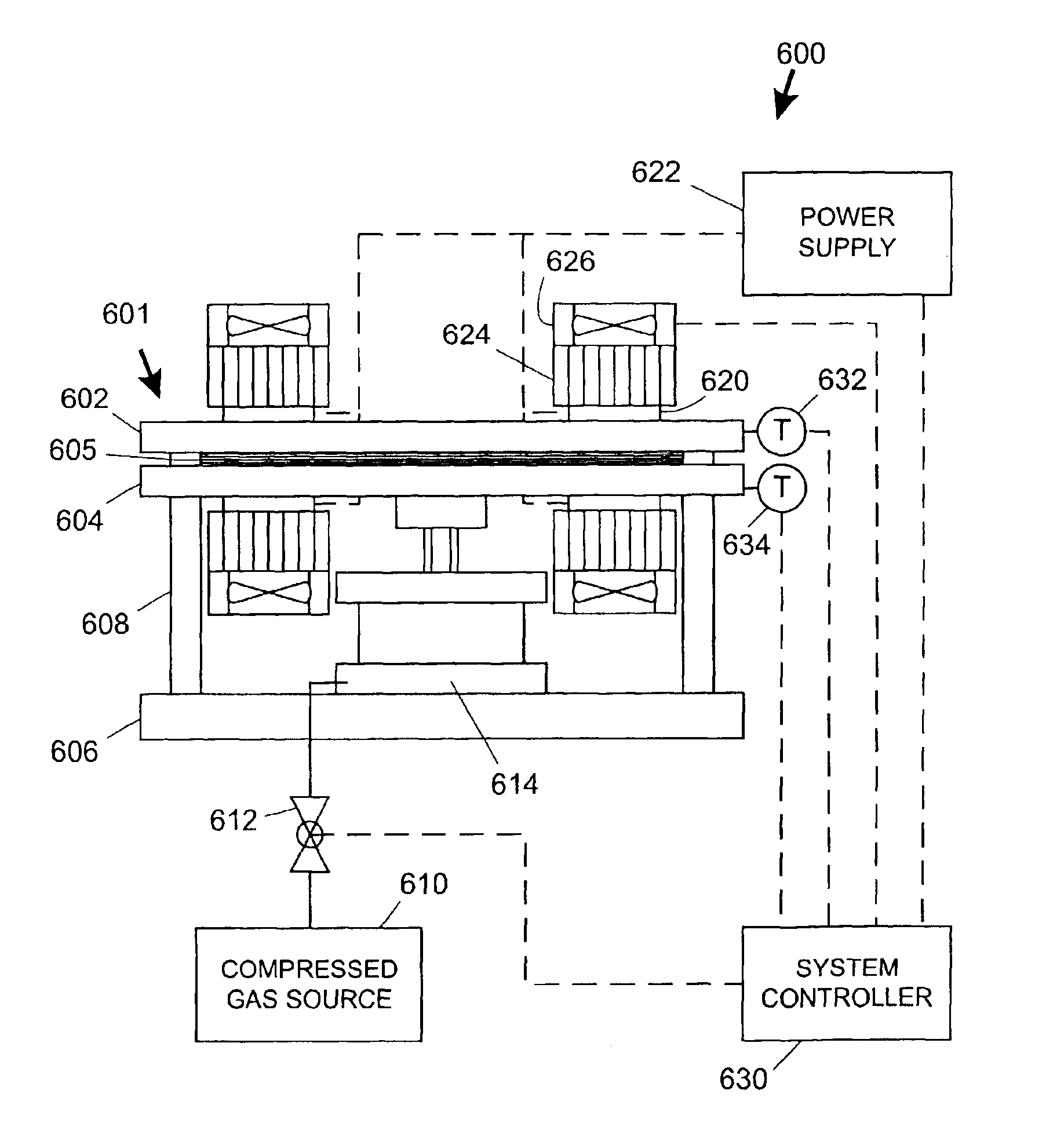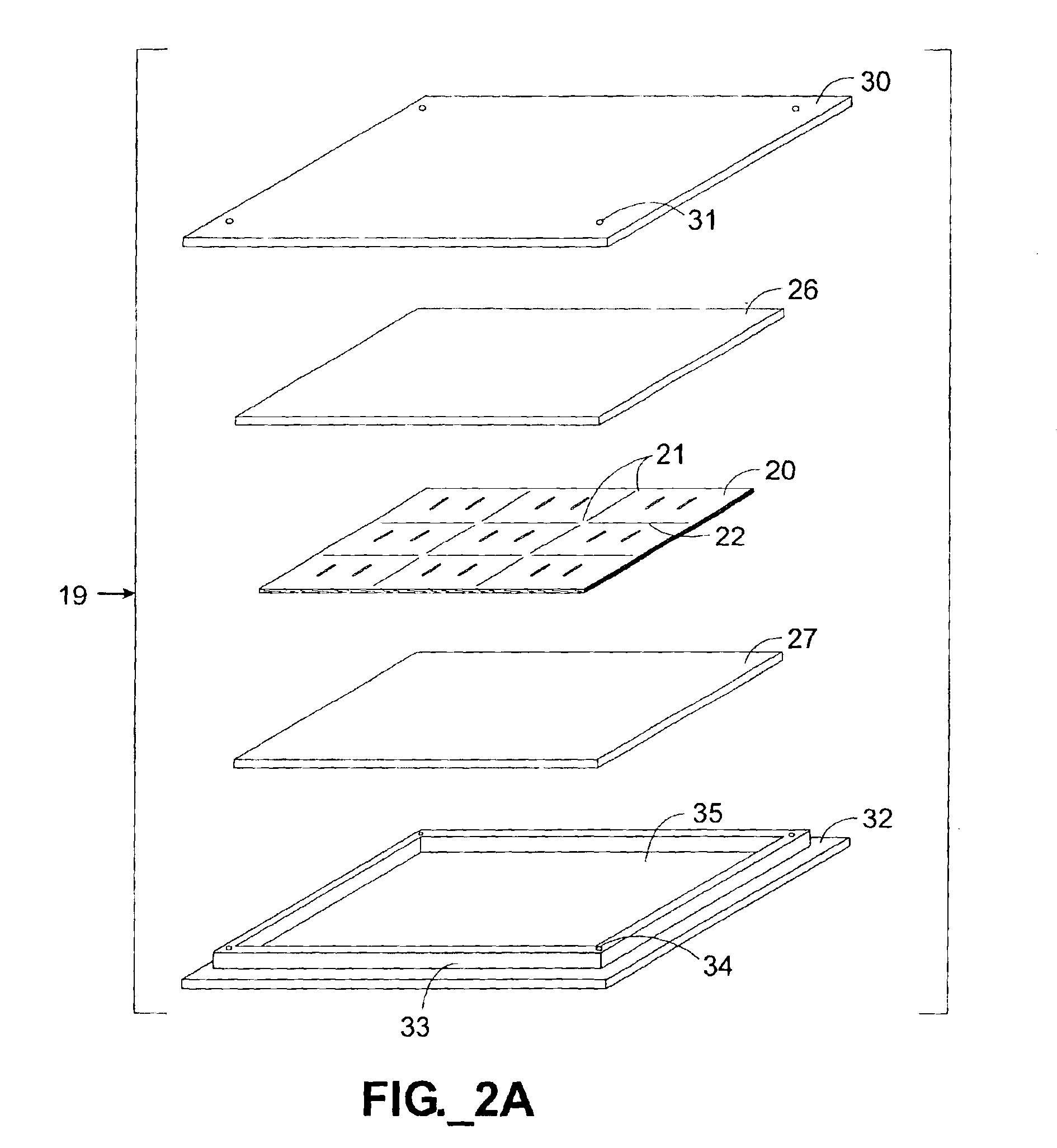Adhesiveless microfluidic device fabrication
a technology of microfluidic devices and adhesives, which is applied in the direction of electrolysis, diaphragms, chemical vapor deposition coatings, etc., can solve the problems of complex biochemical reactions and processes, unfavorable application in other applications, and the ability of adhesives to be susceptible to undesirable interactions with certain chemical solvents, etc., to enhance the fabrication method and high inter-layer bond strength
- Summary
- Abstract
- Description
- Claims
- Application Information
AI Technical Summary
Benefits of technology
Problems solved by technology
Method used
Image
Examples
example 1
Several copies of a square adhesiveless microfluidic channel-containing device were constructed with three device layers 51-53, with edge lengths of about 2.5 inches (6.4 cm). Referring to FIGS. 3A-3B, in each device the first (cover) layer 51 defined an inlet port 55 and an outlet port 56 for each channel 57. Eight channels 57, each 40 mils (1 mm) wide, were cut into and through the entire thickness of the central stencil layer 52. The third (cover) layer 53 served to enclose the channels 57 from the bottom. Each layer 51-53 defined two alignment holes 58, 59 to aid in aligning the layers 51-53 when stacking atop an alignment jig with raised pegs (not shown). The three layers 51-53 were each formed of 7.5 mil (188 micron) thickness unoriented “Clear Tear-Seal” polypropylene (American Profol, Cedar Rapids, Iowa) and stacked together. No adhesives or metallic bonding agents were used.
In one batch, the channels 57 were cut with a computer-controlled laser cutter. Multiple (i.e., four)...
example 2
Another batch of devices 50 identical in appearance to those described in Example 1 was prepared. The only difference in preparing the device layers 51-53 before stacking was that the channels 57 were cut using a plotter that was modified to manipulate a cutting blade. Nine aligned identical stacks of layers 51-53 were prepared and tack-welded at two locations each using a laser to provide a localized weak bond between layers. This welding step locally heated the material to approximately its melting point but did not burn or remove any material. This localized welding was performed to prevent slippage between layers 51-53 when placed within a compression jig.
The nine stacks were placed symmetrically, in three rows of three stacks each, between glass platens in a compression jig according to FIGS. 2A-2D. In this example, the compression springs 38 were each approximately ⅝ inch (16 mm) in length, 0.24 inch (6.1 mm) in diameter, and had a spring rate of about 28 pounds / inch (5.0 kg / c...
example 3
Multiple copies of a microfluidic channel-containing device were constructed using five device layers 71-75. As shown in FIGS. 4A-4B, three stencil layers 72-74 were sandwiched between a first and a second cover layer 71, 75. The first layer 71 defined multiple inlet and outlet ports 77, 78. Eight channels 80, each approximately 40 mils (1 mm) wide were cut into and through the entire thickness of the second (stencil) layer 72, along with vias 81 and 82 for communicating with channels 84, 88 in the third and fourth layers 73, 74. The third layer 84 and the fourth layer 88 were stencil layers each defining eight channels 84, 88, with the third layer additionally defining vias 85, 86 for communicating with the channels 88. The channels 80, 84, 88 were all slightly offset from one another, as clearly depicted in FIG. 4B. The fifth layer 75 served as a base for sealing the channels 88 defined in the fourth layer 74. All five layers 71-75 were formed of 7.5 mil (188 micron) thickness uno...
PUM
| Property | Measurement | Unit |
|---|---|---|
| Fraction | aaaaa | aaaaa |
| Fraction | aaaaa | aaaaa |
| Fraction | aaaaa | aaaaa |
Abstract
Description
Claims
Application Information
 Login to View More
Login to View More - R&D
- Intellectual Property
- Life Sciences
- Materials
- Tech Scout
- Unparalleled Data Quality
- Higher Quality Content
- 60% Fewer Hallucinations
Browse by: Latest US Patents, China's latest patents, Technical Efficacy Thesaurus, Application Domain, Technology Topic, Popular Technical Reports.
© 2025 PatSnap. All rights reserved.Legal|Privacy policy|Modern Slavery Act Transparency Statement|Sitemap|About US| Contact US: help@patsnap.com



